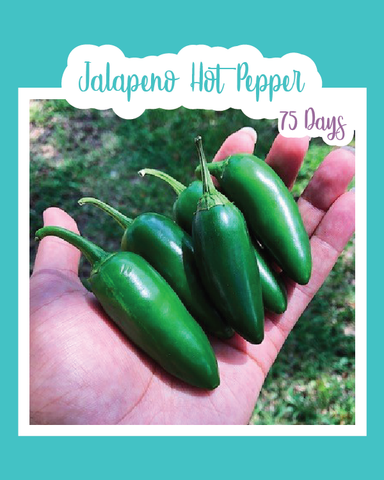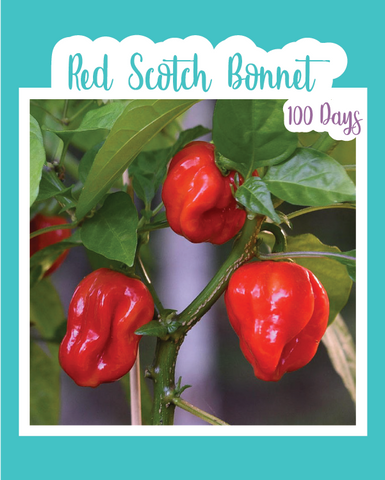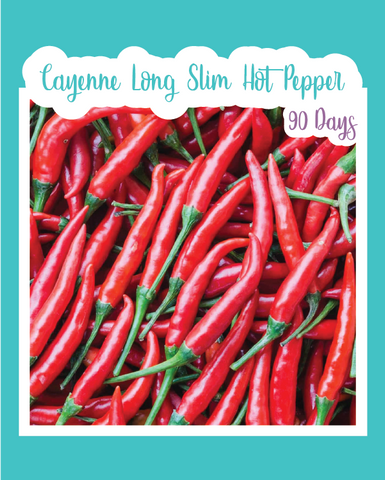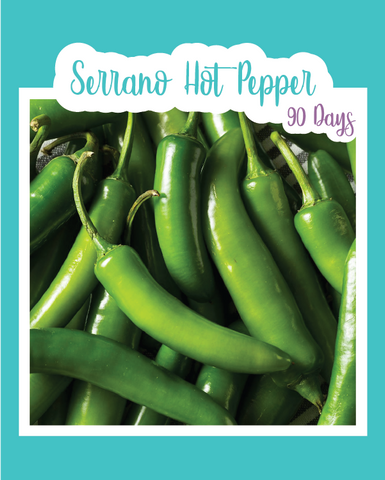
Red Ghost Hot Pepper (Bhut Jolokia)
Seed Count: Approx. 10 seeds
Days to Maturity: 100-120 Days from transplant
Description: The Ghost pepper, aka the Bhut Jolokia, is one of those extremely hot peppers that I can not get enough of. Every year, I make sure to find a spot for it in my garden. Originally from Northeast India, this bright red, tasty fire baby hits spice levels over 1,000,000 Scoville Units! The 2-3 inch fruits have thin walls, with wrinkled skins, and pointed tips. Its rich, smokey flavor is great to add to curries, chutneys, and pickles. Just remember that a little bit of this pepper truly goes a long way. However, I think my favorite thing to make with these peppers are pepper jams (I make a guava, cotton candy grape, ghost pepper jam that's to die for with these bad boys), that I then later use in charcuterie boards, or to make bbq sauces. Ghost pepper plants are extremely slow growing, however, I've had some of my plants reach over 4 ft. tall, and get loaded with more peppers than I actually need, once they're finally ready.
Please remember to handle these with care, and use gloves. I have literally swollen my eyes shut messing with hot peppers ungloved, thinking I washed my hands well enough after handling them. I have never been so wrong. Totally worth it though, because that curry was immaculate.
Mint2Grow Tip: Add whole peppers to your curries and other dishes, but be sure the pod doesn't break open, or your dish may be spicier than you intended. I, however, like to cut up whole peppers to add to my curries, jerk chicken, and seafood soups for that super extra spicy kick, since I have island gyal running through my blood, and like my curries and jerk chicken spicier than most. I also dry super hot peppers and make pepper flakes with them; my husband sprinkles them literally on everything, and doesn't eat a meal without them.
**THESE SEEDS CAME DIRECTLY FROM MY GARDEN AND MY BE CROSS POLLINATED**
While I do not spray my plants with anything, I can not officially offer these as organic. However, they are organically grown.
How To Grow
Sowing: Start pepper seeds indoors in peat pots, about 8 weeks before your last expected spring frost. Sow them 1/4 of an inch deep, and keep the soil at 80-85 degrees F until they germinate. If the soil is too cold it may not germinate. I also find that the hotter the pepper is, the longer those seeds take to germinate. Provide seedlings with adequate sunlight or a grow light for 12-16 hours a day. When the outdoor temperature reaches 60-65 degrees F during the day and no less than 50 degrees F at night, you can transplant your seedlings. Space them about a foot and a half apart. Exposing the plants to the weather for several hours a day before transplanting may help prevent transplant shock. Peppers grow well in containers or raised beds. I grow mine in 5-10 gallon grow bags depending on how big the variety will eventually get. Since I live in a warmer climate, they become full sized, and can survive for over a year, so I have to take that into consideration when choosing their homes.
Growing: Keep the soil evenly moist and weeds under control. Mulching your plants may help with this. If excess heat and sun cause the plants to wilt, provide shade them with shade and ample water, but be careful not to over water them. Usually my peppers survive my hot summers, so I wouldn't worry much about it. Peppers are prone to blossom end rot, so I always make sure to start them with high amounts of nutrients, so I always mix in powdered egg shells, bone meal, and Epsom salt into the soil. I also feed them with fish emulsion and Fox Farm's Tiger Bloom, once a month, to ensure that I get lots of peppers with none of the rot. My peppers always get plagued with white flies, aphids, and scale, so an organic horticultural spray could be beneficial. Companion plant with basil, coriander, onions, spinach, and tomatoes but do not inter-plant with beans.
Harvesting: When to harvest hot peppers is basically a matter of personal preference. Generally speaking, the longer the peppers mature on the vine, the hotter they will taste. I've also found that decreasing the amount of water, as they mature, makes for significantly hotter peppers. Mature peppers will signal the plant to stop producing, so I pick them often. However, my peppers have always been productive, regardless of if I let them mature on the plant or not. Always use a knife or scissors to remove peppers from the plant to prevent damage to their fragile stems. Peppers are extremely versatile and can be used fresh, dried, or for seasoning. You can even make delicious pickled peppers or delicious pepper sauces and pastes. If you plan to save seeds, keep in mind that peppers will cross pollinate with other varieties of pepper, so isolation may be necessary to preserve its genetic purity. Allow peppers to fully mature, then cut them open, and remove the seeds. I give the seeds a little rinse, then I spread out the seeds to dry for about two weeks. Store the seeds in a cool, dry place for up to two years.




